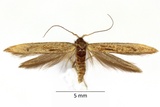Coleophora clypeiferella Hofmann O., 1871 Species
Last modified: Nov. 27, 2025, 8 p.m.
This is a very rare species in Belgium, not often recorded.
Details
- Classification
- Family: Coleophoridae > Genus: Coleophora > Species: Coleophora clypeiferella
- Vernacular names
- Roetstreepkokermot (NL), Body-marked case-bearer (EN)
- First mention in Belgium
- Janmoulle E. 1952a. Espèces nouvelles pour la faune belge (suite). — Lambillionea 52: 13, 25–26, 49–50. On page 50.
- Status
-
Native
Distribution
Imago
Wingspan 12–16 mm.
The colour of this moth is predominantly brown, but it can vary from ochreous-yellow through brown to rust-brown. <BR<
The antennae are ringed alternately till the tip. The base of the antennae is thickened to 1/4 of their length.
The moths have a specialized sclerotized plate carrying small spines on the dorsal side of the first two abdominal segments. This structure is thought to be useful at hatching. It is worth noting that this is the only Western European species having this kind of plate. For a detailed picture of this structure: see on Lepiforum.
See also bladmineerders.be.
Bionomics
The larva of this species feeds on the seeds of Chenopodium album. Initially, the young caterpillar lives in a silken tube between the seed heads but, later on, adds seed- and flower fragments to the case. At that moment, in September and October, the cases are the easiest to find. When full-grown, the larva lets itself drop to the ground, leaves the case, and constructs a brown and parchment-like cocoon to hibernate.
The adult moths are attracted to light.
Flight periods
The moths fly predominantly in July, sometimes also in the first half of August.
Observed on
- Host plant (species):
- Chenopodium album
- Host plant (genera):
- Atriplex
The caterpillars feed monophagously on Chenopodium album although the genus Atriplex is also mentioned in literature.





